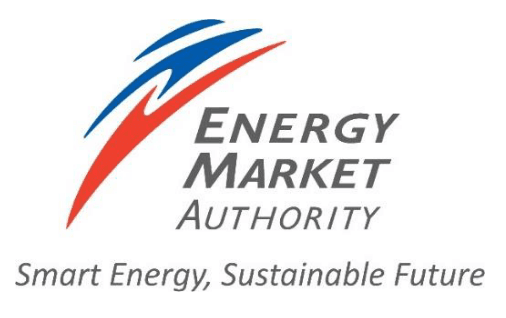Media Release
Leveraging Digital Solutions to Future-Proof Singapore’s Energy Grid

As part of Singapore’s energy transition, the Energy Market Authority (EMA), together with industry partners, have embarked on digital projects to future-proof the nation's energy grid infrastructure. There has been good progress in the development of Singapore’s first Grid Digital Twin and Distributed Energy Resource Management System, and they will continue to be developed over the next few years. These projects will serve to enhance the resilience and reliability of Singapore’s electricity grid and support the deployment of cleaner energy sources.
Grid Digital Twin
2. Singapore embarked on the Grid Digital Twin in 2021 with the aim of enhancing Singapore’s grid resilience, reliability, and support the deployment of cleaner energy sources. The Grid Digital Twin, comprising two key models - Digital Asset Twin and Digital Network Twin - is a virtual replica of the physical grid network and infrastructural assets. Created in collaboration with Government agencies, industry players and academia, research and development for Singapore’s first Grid Digital Twin for the national power grid has demonstrated good progress.
Digital Asset Twin
3. The Digital Asset Twin is a virtual replica of SP Group’s electricity network assets. Developed by the SP Group, in collaboration with Nanyang Technological University (NTU), the Digital Asset Twin aims to enable network operators to monitor and analyse the condition and performance of grid assets, in order to mitigate potential issues. When fully developed, it is envisaged that the Digital Asset Twin will also enable informed decisions for prioritised and timely renewal and maintenance of grid assets.
4. Through in-house digital development capabilities, SP Group has built the core of the asset dashboard as well as key Artificial Intelligence (AI) engines and algorithms to integrate with sensors in real time. The SP-NTU Joint Lab will provide components of an Asset Health system and cost-effective condition monitoring sensors. SP Group targets to deploy a pilot by 2025. As costs of sensors, digital and communication solutions reduce, they can potentially be applied to the large number of distribution assets, such as the 18,000 transformers across SP’s 12,000 substations.
Digital Network Twin
5. EMA has also collaborated with partners such as S&TPPO, A*STAR’s Institute of High Performance Computing (IHPC), and TUMCREATE to develop the Digital Network Twin within the Singapore Integrated Transport and Energy Model (SITEM). With the development of the Digital Network Twin, it enables SITEM to make use of advanced modelling and simulation software to model the impact of additional Electric Vehicle (EV) demand on the grid and identify necessary infrastructure upgrades under different scenarios. This has provided insights to EMA and SP Power Grid (SPPG) on how substation capacity could be optimised to support EV charging. The Digital Network Twin is currently undergoing the next stage of translational research and development in order to deploy the developed solutions into an end-user software solution usable by EMA by 2025. The software solution will help to assess the impact of significant demand changes expected in the distribution grid as energy sector decarbonises.
6. A*STAR has also incorporated high-resolution electricity demand results obtained from the Digital Network Twin into a national-level energy systems model that aims to optimise Singapore’s long-term decarbonisation pathways. The effort has yielded positive initial outcomes through the identification of potential ways to reduce investment costs in the power sector over the next 30 years, as the nation seeks to achieve net zero emissions by 2050. EMA will also work with A*STAR and other partner agencies, through the Centre for Energy and Emissions Modelling (CE2M), to further improve long term power sector decarbonisation planning.
7. Through these initiatives, Singapore will have smarter and more efficient ways of monitoring and predicting the health of the nation’s grid assets and network. In addition, the Grid Digital Twin allows for a risk-free environment to study and test different scenarios. This will help future-proof Singapore’s power grid by ensuring that it is well-equipped to manage increasing electricity demand and changes in energy supply, while maintaining reliability in grid operations.
Distributed Energy Resource Management System (DERMS)
8. Distributed Energy Resources (DERs) like solar generation systems, battery Energy Storage Systems (ESS), and Electric Vehicles (EVs) are likely to proliferate in the coming decades. This is because solar power generation and battery ESS are expected to become cheaper and more efficient, given ongoing research and development efforts as well as economies of scale. As such, it is increasingly vital to ensure that Singapore’s grid infrastructure is able to support the integration and deployment of cleaner energy sources.
9. To better optimise the management of small-scale DERs such as solar and EVs across the network, SPPG has embarked on pilot development for a Distributed Energy Resource Management System (DERMS). DERMS is a monitoring and control platform which aims to support SPPG’s network operators with real-time information and control capabilities to optimise DER connections.
10. SP Group has carried out a proof-of-concept in 2021, to explore use cases where monitoring and control of DERs could support network operations. From this first phase, monitoring and control solutions were trialled on test setup to gain first-hand experience and identify potential applications for Singapore’s context.
11. The next phase of the DERMS pilot is focused on solar forecasting and capabilities to prepare for increasing EV adoption, and will be test-bedded at selected SP substations. When fully developed, DERMS will be able to support network operators in the sustainable integration of solar and EV-related DERs into the network, while effectively managing reliability and system costs.
ANNEX A: Factsheet on Singapore National Grid Digital Twin
-- End --
About the Energy Market Authority
The Energy Market Authority (EMA) is a statutory board under the Singapore Ministry of Trade and Industry. Through our work, we seek to build a clean energy future that is resilient, sustainable, and competitive. We aim to ensure a reliable and secure energy supply, promote effective competition in the energy market and develop a dynamic energy sector in Singapore. Visit www.ema.gov.sg for more information.
About the SP Group
SP Group is a leading utilities group in the Asia Pacific, empowering the future of energy with low-carbon, smart energy solutions for its customers. It owns and operates electricity and gas transmission and distribution businesses in Singapore and Australia, as well as sustainable energy solutions in Singapore, China, Thailand and Vietnam.
As Singapore’s national grid operator, about 1.6 million industrial, commercial and residential customers benefit from its world-class transmission, distribution and market support services. These networks are amongst the most reliable and cost-effective worldwide.
Beyond traditional utilities services, SP Group provides a suite of sustainable and renewable energy solutions such as microgrids, cooling and heating systems for business districts and residential townships, solar energy solutions, electric vehicle fast-charging stations and digital energy solutions for customers in Singapore and the region.
For more information, please visit spgroup.com.sg or follow us on Facebook at spgrp.sg/facebook, LinkedIn at spgrp.sg/linkedin and Instagram at spgrp.sg/Instagram.
ANNEX A: FACTSHEET ON THE SINGAPORE NATIONAL GRID DIGITAL TWIN
1. A digital twin is a virtual model of physical infrastructure, processes and systems that can carry out various functions such as intelligent data analysis, computer modelling and simulation and machine learning to support users in improving planning and decision-making processes.
2. The digital twin of Singapore’s national grid will comprise two key models:
a. Asset Twin to optimise the planning, operations and maintenance of SP’s grid assets (such as substations, transformers, switchgears and cables). The Asset Twin is able to remotely monitor and analyse the condition and performance of assets and identify potential risks in grid operations early. This allows SP Group (SP) to make informed decisions on renewal and maintenance plans accordingly.
Through in-house digital development capabilities, SP Group has built the core of the asset dashboard and the initial key AI engines and algorithms to integrate with sensors in real time. The SP NTU Joint Lab will provide components of an Asset Health system and break-through cost effective condition monitoring sensors. SP Group targets to deploy a pilot by 2025. As costs of sensors, digital and communication solutions reduce, these digital solutions can potentially be applied to the large number of distribution assets, such as the 18,000 transformers across 12,000 substations.
The Asset Twin is underpinned by five research projects awarded by the Energy Market Authority (EMA) to SP and Nanyang Technological University (NTU) under the SP Group - NTU Joint Laboratory[1].
b. Network Twin for impact assessment on grid. This uses modelling and simulations to determine the impact of additional loads (such as charging of electric vehicles) and distributed energy resources (such as solar photovoltaics and energy storage systems) on the grid.
Using an advanced software framework known as the Multi Energy System Modelling & Optimisation (MESMO)[2], the Network Twin is able to provide EMA and SP with a high-level assessment of the impact of demands on the grid and any upgrades required for different scenarios.
EMA and agencies such as A*STAR’s IHPC, S&TPPO, and TUMCREATE, have developed the Singapore Integrated Transport and Energy Model (SITEM) to model the impact of additional Electric Vehicle (EV) demand on the grid and identify necessary infrastructure upgrades under different scenarios. SITEM has provided insights on how substation capacity can be optimised to support EV charging.
The first prototype Network Twin was developed as part of the SITEM project by the Institute of High Performance Computing (IHPC) at the Agency for Science, Technology and Research (A*STAR), together with its technology partner TUMCREATE Ltd. The project was funded by the Public Sector Science & Technology Policy & Plans Office (S&TPPO).
IHPC is currently undertaking the next stage of translational R&D that aims to deploy the Network Twin into an end-user software solution usable by EMA engineers by 2025.
EMA will work together with A*STAR and other partner agencies in the Centre for Energy and Emissions Modelling (CE2M), which seeks to support long-term national decarbonisation planning. The initiative aims to develop a federated systems architecture that integrates the national energy system model, with sectoral models such as power and transport. The modelling effort would better inform Singapore’s net-zero strategy, including our future power grid.
3. Key benefits of the Grid Digital Twin are:
a. Enhanced condition monitoring of assets and prioritisation of asset renewal, by having a decision tool that can identify risks and prioritise grid assets renewal plans. The tool will take into account health, utilisation and failure history of the grid assets.
b. Improvement in carrying out network planning analysis by having a better network utilisation when balancing new or peak electricity loads.
c. Optimisation of asset investment, by identifying potential synergies between asset renewal and upgrades for load growth without compromising grid resilience.
[1] The SP Group - NTU Joint Lab was established between SP Group and NTU in 2020, to explore energy-related projects in the areas of asset management and network operations.
[2] MESMO is one of two primary simulation technologies that is used in the Singapore Integrated Transport Energy Model (SITEM) project. More details on SITEM can be found on A*STAR’s website: www.a-star.edu.sg/News-and-Events/a-star-news/news/press-releases/supporting-singapore-s-transition-to-electric-vehicles.






